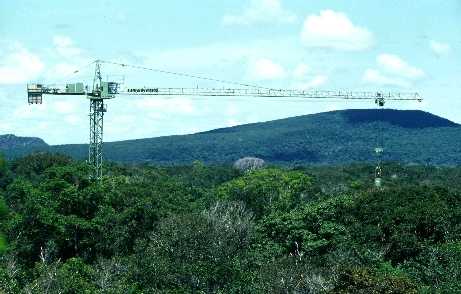

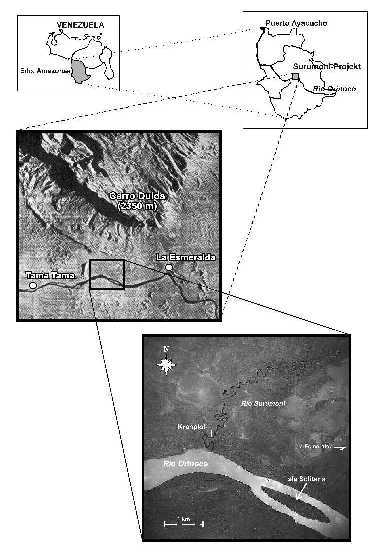
Our studies are embedded within the interdisciplinary research project "Towards an understanding of the structure and function of a neotropical rain forest ecosystem with special reference to its canopy" (Proyecto Surumoni) at the Centro Humboldt, La Esmeralda. The project is organized by the Austrian Academy of Science in collaboration with CONICIT, MARNR, SADA-AMAZONAS and the CAIAH ("Estación Humboldt", La Esmeralda, Venezuela). We start working in 1995; end of field work was summer 2000.
Geographical situation:
The study plot is situated on the banks of the black water river Surumoni, near its junction with the Orinoco at about 100 m elevation, near the small settlement La Esmeralda. Geologically the area is part of the Guyana Shield, one of the two oldest landmasses of South America. Just 15 km north of the study site a huge table mountain massif, the Cerro Duida rises to 2350 m in elevation (see Figure below). The average annual temperature is 26.5°C, and rainfall normally does not exceed 2700 mm/year. The dry season is between December and March. The forest is between 25 and 32 meters high, stands on poor lateritic sand soils and has an irregular crown closure. The study plot is surrounded by a vast ombrophilous lowland forest that has remained largely untouched by human influence.
Vascular epiphytes are an important component of neotropical rain forest ecosystems. In the research plot, species diversity and structure of epiphyte communities are described. With that knowledge as a base the community dynamics can be observed and factors influencing community structure can be analyzed. The scientific aim is to work out a model of structure and function of epiphyte communities in the study area.
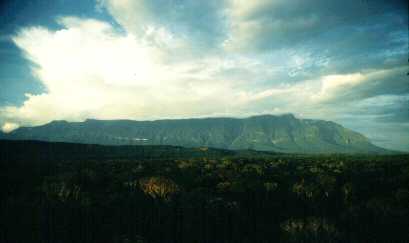
View from the crane at the roof of the Amazonian rain forest in southern Venezuela in front of the table mountain "Cerro Duida". (Photo: S. Engwald).
Research principle and concept:
In principle, all investigations are non destructive, keeping disturbances at a minimum and are mainly based on observations carried out from the crane. The crane was used as observation platform and working tool. This crane is 40 m high, its boom is 40 m long and it runs on rails along a length of 120 m. This technique allowed for the first time ever a complete survey of epiphytes in the 1.5 ha plot. Sampling of voucher specimens and additional investigations were conducted outside the crane plot using the single rope climbing technique with alpine climbing kit.
Our studies consist of two phases:
In phase I (1995-1997), the structure and species diversity of epiphyte communities in the canopy could be described. Therefore it was necessary to identify all vascular epiphytes occurring in the plot to species level. Identification of plants was done in the field as far as possible. If this was not possible, herbarium and alcohol specimens had to be collected for the correct determination. The specimens were determined in the herbaria at Puerto Ayacucho (TFAV), Mérida (MERC) and Caracas (VEN), in collaboration with scientists of these institutes. The crane as observation tool enabled us to reach every position in the forest and to look at the distribution of epiphyte species in the canopy. Distribution patterns as occurrence in particular areas of the canopy or of tree crowns, clustered occurrence of certain species or growth of certain epiphytes on certain phorophytes were mapped in detail and documented photographically.
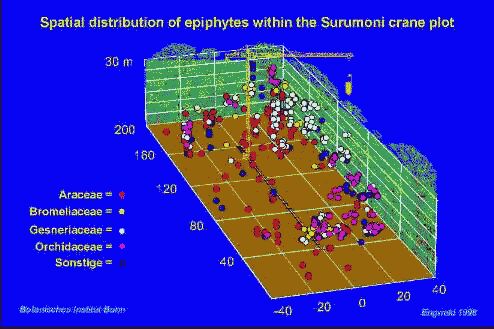
Schematic presentation of the three dimensional distribution of epiphytes in the Surumoni crane plot. Most abundant families are marked by different colors. Each dot represents one epiphyte individual; many individuals are not visible due to mutual overlap. Published in Engwald 1999 and Engwald et al. 2000.
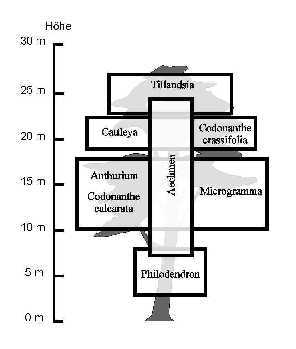
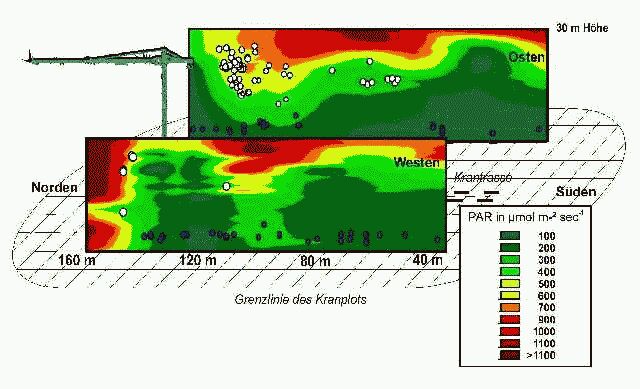
Spatial distribution of epiphytes (Aechmea tillandsioides: white dots, Philodendron fragrantissimum: blue dots) and photosynthetically active radiation (PAR) within the Surumoni crane plot.
Red to brown areas: high radiation values above canopy; yellow area: outer canopy; dark green area: low radiation values within vegetation - subcanopy. Aechmea tillandsioides is a CAM-plant, preferable growing in ant nest, whereas Philodendron fragrantissimum is an hemiepiphytic aroid, which only occurs in the subcanopy. Engwald 1999 (in cooperation with J. Szarzynski, University of Mannheim).
Phase
II (1998-2000) is based on the descriptive data
gathered in phase I. It deals with the analysis of factors influencing
the structure of epiphyte communities, the observation of dynamic processes
and their sequence in time (succession). Interactions between epiphytes (competition)
and interactions between epiphytes and other organisms (e.g. dispersal of
seeds by animals, overall ants: substrate providing by ants) are studied.
Most important for the investigation program of phase II are detailed and
continuous observations and the collaboration and exchange of data with all
working groups and scientists engaged in the project. Epiphyte data (three
dimensional growth positions) of various counts has been integrated in a GIS
(Arcveiw) and can be compared now (species- and individual turnover).
The non destructive principle, keeping disturbances at a minimum, and the
possibility to repeat observations at distinct positions in the canopy by
using the crane ensures data of high scientific value.
To open a pdf-file with a summary and first results of our works within the Surumoni crane project, please click Engwald, Schmit-Neuerburg & Barthlott 2000!
Publications